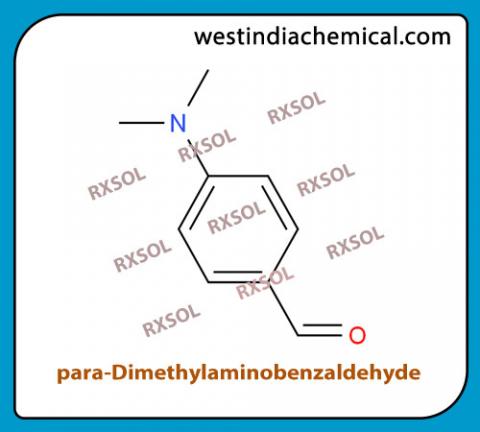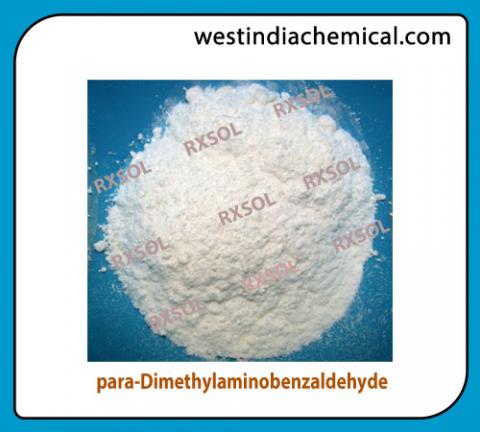Primary tabs


para-Dimethylaminobenzaldehyde
SKU::RXSOL-60-5524-100
Containing amine and aldehyde moieties which is used in Ehrlich's reagent and Kovac's reagent
para-Dimethylaminobenzaldehyde supplier in various packing and size. p-Dimethylaminobenzaldehyde is Stable under ordinary condition, Light sensitive. We are the name to reckon with bulk orders of P-dimethylaminobenzaldehyde from Mumbai, Maharashtra. For years, we have maintained our goodwill among the topmost manufacturers and suppliers of P-dimethylaminobenzaldehyd.
para-Dimethylaminobenzaldehyde is the main ingredient in Ehrlich's reagent. And p-Dimethylaminobenzaldehyde reacts with hydrazine to form an azo-dye which has a distinct yellow color. The P-dimethylaminobenzaldehyde is in high demand as it is ideally used as an intermediate for dyes and pharmaceuticals. Our unique and pristine range of P-dimethylaminobenzaldehyde is processed using high-grade raw materials, and checked on numerous parameters of quality in order to deliver the perfect range.
para-Dimethylaminobenzaldehyde used for indicators as change in physical appearance, e.g., color, at or approaching the endpoint of a chemical titrationthe detection, identification, analysis, etc. of chemical, biological, or pathologic processes or conditions. I, e.g., on the passage between acidity and alkalinity. Reagents are substances used for the detection or determination of another substance by chemical or microscopical means, especially analysis. Types of reagents are precipitants, solvents, oxidizers, reducers, fluxes, and colorimetric reagents.
Physical and Chemical properties:
Synonyms: 4-(dimethylamino)benzaldehyde; 4 dimethylaminobenzenecarbonal; Erlichs Reagent
CAS No.: 100-10-7
Molecular Weight: 149.19
Chemical Formula: (CH3)2NC6H4CHO
Molecular formula C9H11NO
Appearance White crystalline powder
Purity By GC, using Capillary Column : 99.42%
Melting Point 72 -75 C
Boiling Point 176 – 177 C
Solubility : Freely Soluble in Methanol, Benzene, Ether and diluted Hydrochloric Acid
para-Dimethylaminobenzaldehyde manufacturer supplier distributor in Mumbai, Kandla, Kolkata, Vizag, Chennai, India, Fujairah, Dubai, Sharjah, UAE, Gulf, Middle East, Muscat Oman, Kenya Africa. Get the best quality of para-Dimethylaminobenzaldehyde at a competitive price from us. We have ready stock of para-Dimethylaminobenzaldehyde in India, UAE Gulf, Oman, Kenya Africa. Contact us for bulk as well as small orders.
Indole TEST : ( Indole produced by microorganisms )
The ability to degrade amino acid to identify end products to differentiate bacteria.Indole can be detected to the culture growth ( Pure bacterial culture must be grown in sterile tryptophan or peptone broth for 24-48 hours before performing the test. ) by reaction with 5 drops of Kovac’s reagent to produce a red or red violet colour.
KOVAC’S Reagent - ( para-Dimethylaminobenzaldehyde in isoamyl alcohol and Concentrated hydrochloric acid )
Ehrlich Reagent - ( para-Dimethylaminobenzaldehyde in ethyl alcohol and Concentrated hydrochloric acid )
INDOLE TEST is suitable for
Indole-Positive Bacteria that test positive for cleaving indole from tryptophan include: Aeromonas hydrophilia, Aeromonas punctata, Bacillus alvei, most Citrobacter sp., Edwardsiella sp., Escherichia coli,Flavobacterium sp., Haemophilus oxytoca, Proteus sp. (not P. shigelloides, Pasteurella pneumotropica, Streptococcus faecalis and Vibrio species. Bacteria which give negative results for the indole test include: Actinobacillus spp., Aeromonas salmonicida, Alcaligenes sp., most Bacillus sp., Bordetella sp., Enterobacter sp.,Lactobacillus spp., most Haemophilus sp., most Klebsiella sp., Neisseria sp., Pasteurella haemolytica, Pasteurella ureae, Proteus mirabilis, Pseudomonas sp., Salmonella sp., Serratia sp., Yersinia sp.50, 51 Kitasato's discovery that Escherichia coli could be distinguished from Klebsiella species (Aerobacter aerogenes) by virtue of its ability to produce indole initiated the detection of indole production as an accepted analytical tool for the bacteriologist
MECHANISM :
INDOLE TEST chemical concept :::
Principally this test is based on to determine the ability of microbe to degrade the AMINO ACID TRYPTOPHAN.
Tryptophan ——(Tryptophanase)——> Indole + Pyruvic Acid + Ammonia
p-dimethylaminobenzaldehyde ( with Hcl and isoamyl alcohol ) + Indole —-------------> Quinoidal Red - or - Violet Compound
Result : Development of Cherry Red Colour at the interface of the reagent and the broth, within seconds after adding the Kovacs reagent indicate the presence of indole and the test is positive. If no colour change is observed, then the test is negative and so organisms are not capable of producing tryptophanase.




